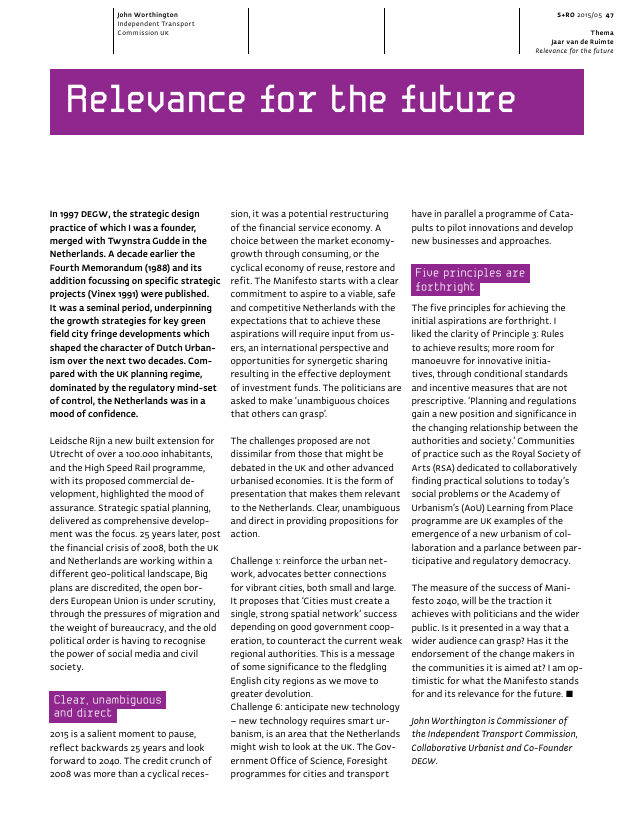In 1997 DEGW, the strategic design practice of which I was a founder, merged with Twynstra Gudde in the Netherlands. A decade earlier the Fourth Memorandum (1988) and its addition focussing on specific strategic projects (Vinex 1991) were published. It was a seminal period, underpinning the growth strategies for key green field city fringe developments which shaped the character of Dutch Urbanism over the next two decades. Compared with the UK planning regime, dominated by the regulatory mind-set of control, the Netherlands was in a mood of confidence.

S+RO 2015/05 47ThemaJaar van de RuimteRelevance for the futureJohn WorthingtonIndependent TransportCommission UKIn 1997 DEGW, the strategic designpractice of which I was a founder,merged with Twynstra Gudde in theNetherlands. A decade earlier theFourth Memorandum (1988) and itsaddition focussing on specific strategicprojects (Vinex 1991) were published.It was a seminal period, underpinningthe growth strategies for key greenfield city fringe developments whichshaped the character of Dutch Urban-ism over the next two decades. Com-pared with the UK planning regime,dominated by the regulatory mind-setof control, the Netherlands was in amood of confidence.Leidsche Rijn a new built extension forUtrecht of over a 100.000 inhabitants,and the High Speed Rail programme,with its proposed commercial de-velopment, highlighted the mood ofassurance. Strategic spatial planning,delivered as comprehensive develop-ment was the focus. 25 years later, postthe financial crisis of 2008, both the UKand Netherlands are working within adifferent geo-political landscape, Bigplans are discredited, the open bor-ders European Union is under scrutiny,through the pressures of migration andthe weight of bureaucracy, and the oldpolitical order is having to recognisethe power of social media and civilsociety.Clear, unambiguousand direct2015 is a salient moment to pause,reflect backwards 25 years and lookforward to 2040. The credit crunch of2008 was more than a cyclical reces-sion, it was a potential restructuringof the financial service economy. Achoice between the market economy-growth through consuming, or thecyclical economy of reuse, restore andrefit. The Manifesto starts with a clearcommitment to aspire to a viable, safeand competitive Netherlands with theexpectations that to achieve theseaspirations will require input from us-ers, an international perspective andopportunities for synergetic sharingresulting in the effective deploymentof investment funds. The politicians areasked to make `unambiguous choicesthat others can grasp'.The challenges proposed are notdissimilar from those that might bedebated in the UK and other advancedurbanised economies. It is the form ofpresentation that makes them relevantto the Netherlands. Clear, unambiguousand direct in providing propositions foraction.Challenge 1: reinforce the urban net-work, advocates better connectionsfor vibrant cities, both small and large.It proposes that `Cities must create asingle, strong spatial network' successdepending on good government coop-eration, to counteract the current weakregional authorities. This is a messageof some significance to the fledglingEnglish city regions as we move togreater devolution.Challenge 6: anticipate new technology? new technology requires smart ur-banism, is an area that the Netherlandsmight wish to look at the UK. The Gov-ernment Office of Science, Foresightprogrammes for cities and transporthave in parallel a programme of Cata-pults to pilot innovations and developnew businesses and approaches.Five principles areforthrightThe five principles for achieving theinitial aspirations are forthright. Iliked the clarity of Principle 3: Rulesto achieve results; more room formanoeuvre for innovative initia-tives, through conditional standardsand incentive measures that are notprescriptive. `Planning and regulationsgain a new position and significance inthe changing relationship between theauthorities and society.' Communitiesof practice such as the Royal Society ofArts (RSA) dedicated to collaborativelyfinding practical solutions to today'ssocial problems or the Academy ofUrbanism's (AoU) Learning from Placeprogramme are UK examples of theemergence of a new urbanism of col-laboration and a parlance between par-ticipative and regulatory democracy.The measure of the success of Mani-festo 2040, will be the traction itachieves with politicians and the widerpublic. Is it presented in a way that awider audience can grasp? Has it theendorsement of the change makers inthe communities it is aimed at? I am op-timistic for what the Manifesto standsfor and its relevance for the future. John Worthington is Commissioner ofthe IndependentTransport Commission,Collaborative Urbanist and Co-FounderDEGW.Relevance for the future

 Toegang tot Ruimte en Wonen
Toegang tot Ruimte en Wonen
Reacties